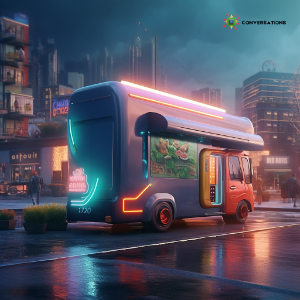Automation in the Pizza industry

Have you thought about how technology is changing the landscape of our urban centres to something you won’t even recognize within a few years? And more importantly, do you have a strategy to deal with this change and even prosper in this new environment?
You need to think about this right now, because your competitors already are and have been, even before AI started to change the game around the world.
Let’s take the pizza industry for example to see what this change means to consumers and especially businesses everywhere:

If you think about pizza as a business, then you have to think tech. Surprised? Isn’t it all about the dough, the ingredients, the marketing? Let’s start with some facts:
- There are over 75,000 pizza stores spread across the United States.
- Approximately 8 employees work at any given time in a single location that’s open for business.
- In the aggregate, around 800,000 employees in the United States are working in the pizza industry. (source)
But the question you have to ask – and it’s a question that decides what franchises and brands succeed, and which fail – is the following:
Can you tell me what the main objective of the pizza business is?
- Yes, it’s about making a profit. However, it’s really about
- Customer stratification, or in other words, fast service, which means an efficient delivery platform. Without that delivery platform, you have no sales, and no profits.
What do you imagine the growth model is right now?
- Do you think of something like: open a location with a sustainable customer base in any given area?
- Think twice, things are already changing and have been changing.
With IT strategy, you can turn this whole industry upside down. Forget the store locations and most of the employees. Are you familiar with Domino’s delivery car? The DXP? Do you know what they carry? A warming oven with room for 80 pizzas! And their ordering system is spread across their own app, as well as Twitter, and even includes texting emojis.
Now, take that strategy to the next level:
Instead of a store with up to a dozen employees and large expensive ovens, you now have an oversized van with all the technology in the back to make a pizza from beginning to end within a precise time. In other words, turn Domino’s warming oven in their delivery cars into the actual pizza-making oven that’s part of a mobile pizza store.
Ok, so Zume pizza is almost there but they still do most of the cooking at their stores. Additionally, while robots do most of the work at Zume and do it better, they still use workers for certain parts of the process. However, the final cooking is done in an array of high-temperature stoves stacked up in their delivery vans as a gps-controlled system calculates to the exact minute when to fire up that last blast of heat to ensure your pizza arrives at your door nice and hot.
So, let’s take the final step and place all of the store – or almost all of it – in the oversized delivery vans.
Here is how it will work.
- Each pizza van will have its area. This area can be fluid depending on demand. For example, the ordering system will continually create a database that will be analyzed, and sliced and diced, in order to predict how a day’s orders may evolve and how to efficiently allocate areas of the city to each pizza van in real time response to incoming orders.
- In the beginning, once the van leaves fully stocked from the central depot, the only human needed is the driver/operator, who will also supervise the automated cooking system, monitor the order platform that will link with major social media as well as the app, and who will of course, take care of the deliveries.
- Customers will have apps, websites, or phones to place orders. Store locations will slowly disappear, likely to be replaced by a central depot where supplies will be distributed to each van.
- A restocking and maintenance crew will still be needed at the depot during the early to mid-term stages of this transformation.
How do you assess the impact of something as revolutionary as this on the pizza industry?
Joseph Schumpeter once defined what he called creative destruction as innovations in manufacturing processes that increase productivity. Unfortunately creative destruction also involves the destruction of some firms along with the creation of new firms. The process he first described over 80 years ago is now moving at warp speed. That means that as a business you have to quickly adapt or ultimately perish.
So, let’s take a look at how tech is transforming something as immediate and tangible as the pizza industry through the lens of creative destruction.
Creative – The Positive Effects:
- No more hair in your pizza! Food safety will be at a new all-time high. No humans handling your food until you actually grab a slice of your pizza. The driver/operator will have a sealed delivery box handed to them by the automated machinery which they then hand to you.
- You can customize your order and (unless you ask for something different the next time you order) it will always be the same when reordering.
- Food delivery will have even faster delivery times and the order will be exactly what you ordered, every time you order.
- Corporate expansion will tend to be lower cost and lower risk. Your continually expanding database that runs your automated platform will tell you when, where, and how to grow your business. You’ll be able to respond to changes in customer demand in real time – adding to or selling off your store-in-a-van fleet.
Destruction – The Negative effects:
- There will be a massive reduction of staff adding to the growing list of people looking for work. Most should find some sort of work but some of them may not.
- There will also be a massive reduction in locally owned, brick-and-mortar pizza locations. There will only be a few novel pizza locations left – stores that put some sort of unique spin on the service that pulls in enough customers to justify the costs.
- Big corporate players in the pizza business – at least the ones who adapt and survive – will use price as the number one tool to fight each other over market share. This makes the whole change not very profitable in the long run but unavoidable.
- That does put more vacant commercial real estate on the market, and it’s hard to predict what sort of demand there will be for another empty store in your neighborhood.
